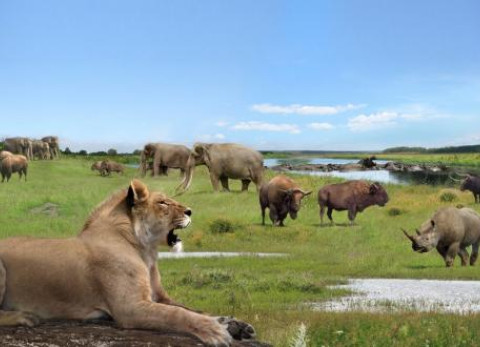Extinction of Pleistocene herbivores induced major vegetation and landscape changes

Extinction of Pleistocene herbivores induced major vegetation and landscape changes
The integrative study by modern and paleo-ecologists shows large herbivores to be major engineers of ‘landscape openness’.
Present-day large herbivores substantially open up otherwise wooded landscapes. This sheds new light on the consequences of the extinction of the very large herbivores that roamed the earth during the Pleistocene. Think of mammoths, ground sloths, diprotodons, and many others.
Ecosystem engineers
Using new techniques, paleo-ecologists have found evidence that shrubs and trees became more abundant following the Late Pleistocene extinctions, and that there were major shifts in plant species composition.
Lead author Liesbeth Bakker from the Netherlands Institute of Ecology explains: “Large herbivores are not merely victims of the circumstances they live in, but actively engineer their environment. This has major consequences for other species, and for the structure of the entire landscape.”
The research team from Europe, the United States and Australia stresses that most research has focused on the causes of the Late Pleistocene large herbivore extinctions. The observed vegetation changes at the end of the Pleistocene were generally attributed to climate change. Until now.
“Acknowledging the major ecosystem-engineering role of large herbivores, you can’t imagine that vegetation stayed the same regardless of their presence or absence in the Late Pleistocene,” says Bakker.
Instead, the team proposes to predict the openness of landscapes based on the diversity of the herbivore community and on actual animal densities. Modern techniques allow further application of this framework for a better understanding of events at the end of the Pleistocene.
Present-day implications
The findings of the study even have implications for our understanding of present-day ecosystem functions, An ‘underbrowsed’ landscape - that is, without large herbivores - leads to increased fire incidences: a phenomenon also observed after the Late Pleistocene extinctions.
Furthermore, contemporary conservation practices have to deal with another decline of native large herbivores, resulting in more wooded landscapes. Or with the opposite case of locally high densities of herbivores such as deer, that lead to increased landscape openness. The present study facilitates a better prediction of both cases.
Publication details
The research was led by the Netherlands Institute of Ecology, in collaboration with the University of Maine, United States; University of Tasmania, Australia; University of Groningen, The Netherlands; University of Oxford, United Kingdom; Carnegie Institution for Science, United States; Aarhus University, Denmark.
It will be published in a special feature of the Proceedings of the National Academy of Sciences USA:
- Paper: Combining paleo-data and modern exclosure experiments to assess the impact of megafauna extinctions on woody vegetation Elisabeth S. Bakker, Jacquelyn L. Gill, Christopher N. Johnson, Frans W. M. Vera, Christopher J. Sandom, Gregory P. Asner and Jens-Christian Svenning (2015). Special Feature, Proceedings of the National Academy of Sciences USA, www.pnas.org/cgi/doi/10.1073/pnas.1502545112.
- A related paper with Liesbeth Bakker as co-author is: Global nutrient transport in a world of giants. Christopher E. Doughty, Joe Roman, Søren Faurby, Adam Wolf, Alifa Haque, Elisabeth S. Bakker, Yadvinder Malhi, John Dunning and Jens-Christian Svenning (2015) Proceedings of the National Academy of Sciences, www.pnas.org/cgi/doi/10.1073/pnas.1502549112
Illustration: Roman Uchytel (http://prehistoric-fauna.com). A British Pleistocene landscape during an interglacial with cave lion (Panthera spelaea), straight-tusked elephants (Palaeoloxodon antiquus), narrow-nosed rhinoceros (Stephanorhinus hemitoechus), steppe bison (Bison priscus), aurochs (Bison primigenius) and hippopotamus (Hippopotamus amphibius).
With more than 300 staff and students, the NIOO is one of the largest research institutes of the Royal Netherlands Academy of Arts and Sciences (KNAW). It specialises in terrestrial and aquatic ecology. As of 2011, it is located in a sustainable research building in Wageningen.
For more information please contact:
- Dr Liesbeth Bakker, senior scientist of the department of Aquatic Ecology at NIOO-KNAW, tel. +31-317-473557 / +31-6-31152935, l.bakker@nioo.knaw.nl
- Froukje Rienks M.Sc., Science Communication Officer NIOO-KNAW, tel. +31-6-10487481 / +31-317-473590, f.rienks@nioo.knaw.nl
